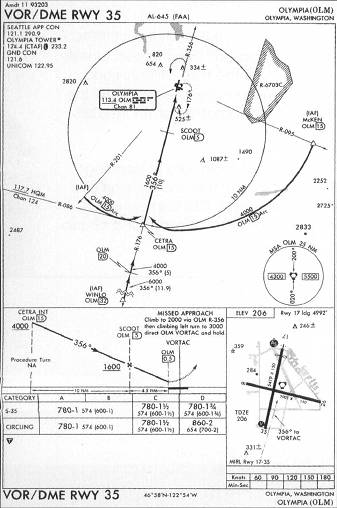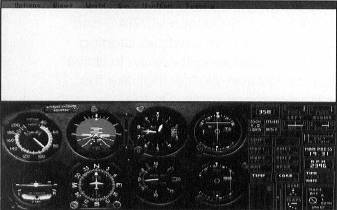Microsoft Flight Simulator Handbook
by Jonathan M. Stern
VOR/DME Approach
A variant of the basic VOR approach is the VOR/DME approach. Although DME may be a useful tool on some VOR approaches, it is required for a VOR/DME approach. If the name of the approach, as stated in the heading section of an IAP chart, includes DME, DME is required. The missed approach point on a VOR/DME approach may be identified by a DME distance or by passing over the VORTAC.
Try flying the VOR DME Rwy 35 approach to Olympia, Washington. The VOR/DME Rwy 35 IAP chart appears in Figure 18.13. Study the chart to see how to fly the approach. I found three IAFs on the approach. Two appear on the 15 DME arc, which you will read about in the next section. The third, and the one you use now, is WINLO intersection, 32 nautical miles South of the Olympia VORTAC.

Perform the unconventional and take off from a rough grass strip Southwest of WINLO intersection. From there, you join the 42° radial from the Astoria VORTAC and fly it to WINLO. Then track inbound on the 176 degree radial from Olympia. Starting with a climb to 6,000 feet MSL, descend at various DME fixes along the way, to arrive at the missed approach point, .5 DME, at the MDA of 780 feet. Notice that, like the terminal VOR approach, no times appear in the time-distance table. On this approach, every fix is identified by a DME distance.
Set up by following these steps:
- Use the World/Set Exact Location menu to set the latitude to N 046° 22' 31.2721", the longitude to W 123° 12' 32.3225", the altitude to three feet, and the magnetic heading to 0.
- Use the World/Weather menu to program an overcast layer of clouds with bases at 600 feet and tops of 950 feet. This gives you a very low stratus overcast effect.
- Prior to a soft field takeoff, set up the cockpit for the flight. Set the NAV 2 to AST, which has a frequency of 114.0. The grass strip is situated very nearby the 42 degree radial, so you should rotate the OBS to select the 42 degree radial and the CDI should come close to the center of the bullseye.
- Set the NAV 1 to Olympia VORTAC, frequency 113.4. Set the OBI to 356° to prepare for your interception of the final approach course. Now you are ready for takeoff.
- Take off from the grass and fly a heading to intercept the 42 degree radial from Astoria. Climb at cruise-climb speed to 6,000 feet.
- When the NAV 1 CDI centers, make a turn onto the final approach course, initially to a heading of 356°. If there is any crosswind, it may be necessary to use a wind correction angle to maintain the course.
The IAP is really quite simple, because it involves descents at various DME distances. First, when the airplane passes 20.0 DME, the airplane may be descended to a minimum altitude of 4,000 feet. At CETRA intersection, defined by 15.0 DME, descent to 1,600 feet is allowed.
- Complete the Before Landing checklist and slow the airplane to approach speed between CETRA and SCOOT. SCOOT intersection, identified by the 5.0 DME, is the final approach fix.
- As you pass over SCOOT, you should lower the landing gear and descend to the MDA, 780 feet. Again, remember to perform a GUMP check after the gear has been lowered.
The missed approach point is identified by the .5 DME point, as shown in Figure 18.14.

If you've followed the instructions thus far, you should be executing the missed approach procedure. You programmed the cloud ceiling lower than the MDA for this approach. This gives you the opportunity to try the approach again in the next subchapter.
Pilots who miss the approach because of low clouds have the choice of going elsewhere, trying a different approach, or trying the same approach again in the hopes that the ceiling will increase in the 10 or so minutes it takes to get set up on the approach again. In real life, the pilot would likely opt to fly the ILS Rwy 17 IAP to Olympia if it were operative, because its minimums are 454 feet rather than 780 feet.
Pause the simulation and proceed to the next section. If you want to continue at a later time, save the situation as Olympic Event.
Table of Contents
Previous Section: Terminal VOR Approach
Next Section: DME ARC Transition
